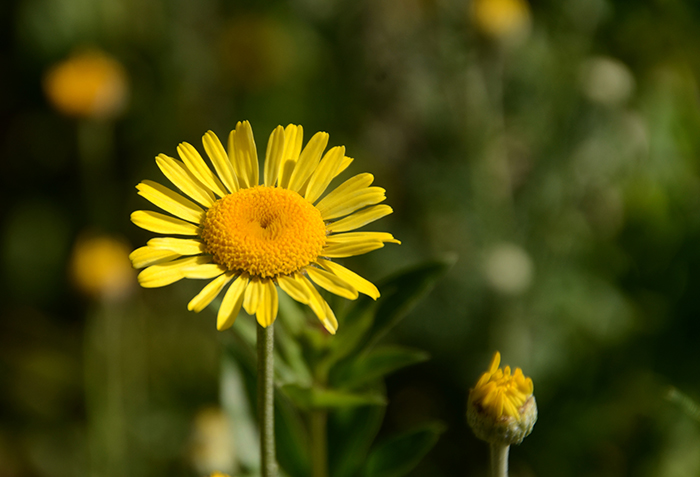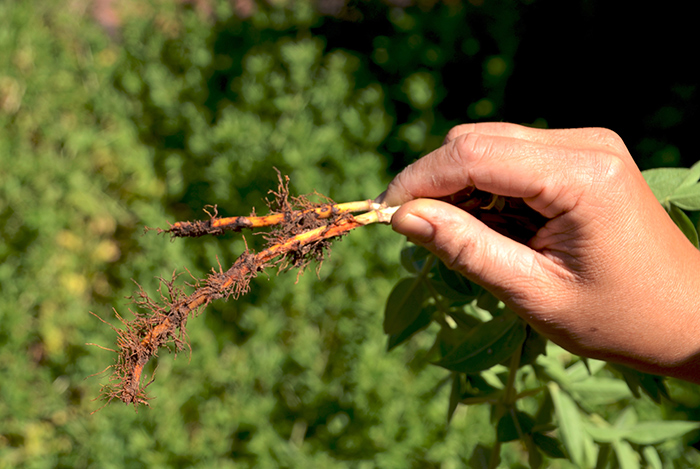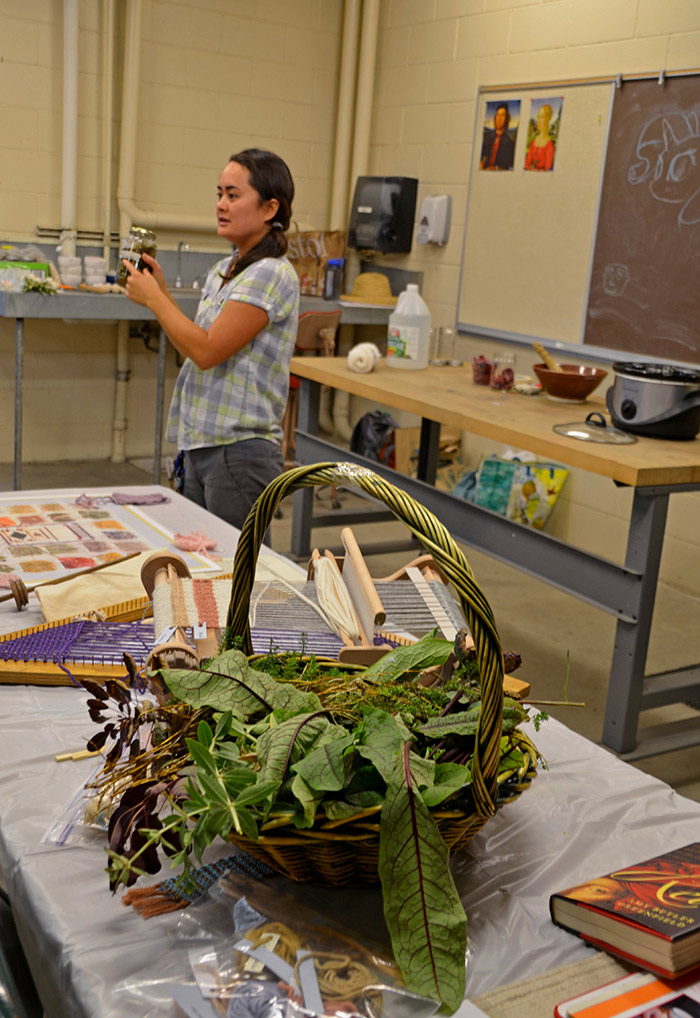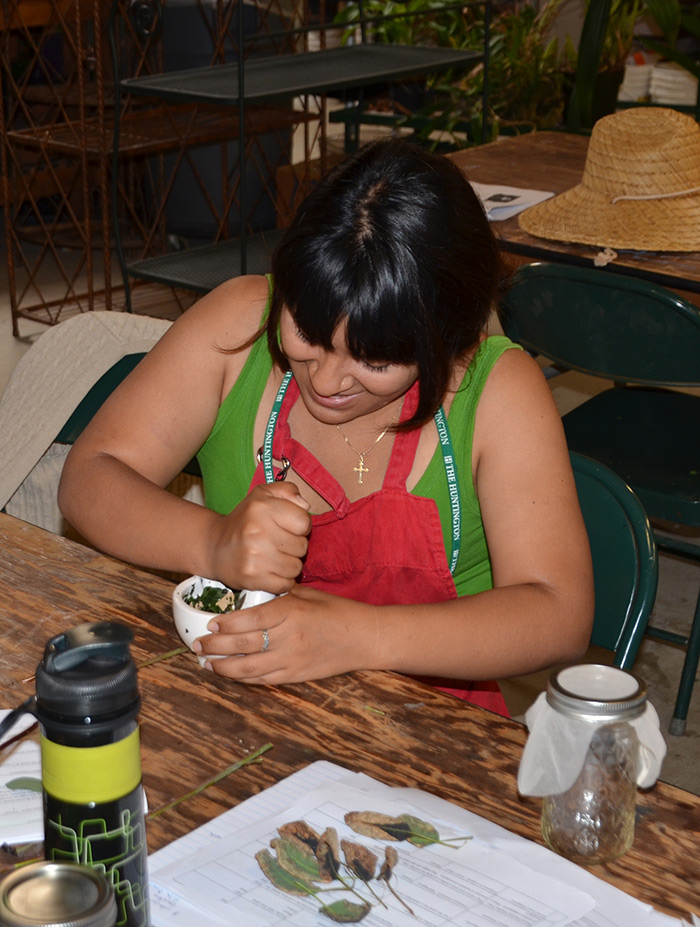The Huntington’s blog takes you behind the scenes for a scholarly view of the collections.
Dyeing to Learn More
Posted on Wed., June 18, 2014 by

In a recent workshop for docents, yarn was dyed with natural pigments extracted from plants in the Herb Garden. (From left: basil flowers, calendulas, onion skins, madder roots, anemone petals, dahlias, and oxalis flowers.) The dyeing session was part of the docents’ preparation for a Fiber Arts Day presentation that will be held in the garden on Saturday, June 21. Photos by Lisa Blackburn.
With its tidy beds of colorful flowers and leafy plants, the Herb Garden might not look like a classroom. But, in fact, that’s precisely what it is. It’s where school children discover where the minty flavor in their toothpaste comes from and where salsa gets its kick. It’s where many adults see hops, flax, and cotton bolls for the first time. It’s where garden docents unlock the mysteries of herbal folklore for visitors and share practical tips for growing and using herbs at home.
The Herb Garden is also a place where docents themselves come to learn. Ongoing training adds to the knowledge that docents can share with visitors and school groups, but there’s no denying that it enhances their personal enjoyment of the Huntington experience at the same time.
A recent workshop on dyeing with natural plant pigments is a perfect example. The session was organized as a way to prepare docents for a June 21 public program where members of local craft guilds will demonstrate the fiber arts of spinning, weaving, and dyeing. Huntington docents will be on hand throughout the daylong event to talk about relevant plants in the garden.

Dyer’s chamomile (Anthemis tinctoria) is one of the traditional dyeing herbs than can be found in the garden. It produces a soft yellow tint.
Gardener Kelly Fernandez, who oversees the Herb Garden, led the morning workshop. It was part of a new volunteer enrichment plan she recently introduced that combines the docents’ bi-monthly meetings with hands-on activities. “Instead of having our meetings in the Botanical Auditorium, we meet in the Herb Garden,” said Fernandez. “This gives us a chance to look at, smell, and touch the plants we’re talking about. The dye and fiber workshop was a perfect opportunity to try out this new approach to learning about the Herb Garden.”
Fernandez and a group of 21 docents gathered in the half-acre garden on a morning in late May, baskets in hand, ready to tackle the first order of business: identifying and collecting a variety of herbs that can be used for dyeing cloth. A section of the Herb Garden is devoted to these plants. Some of them have very long histories as dyes, such as indigo (Indigofera tinctoria) and woad (Isatis tinctoria), which both produce rich blue pigments; madder (Rubia tinctorum), whose roots are ground to extract a red tint; and dyer’s chamomile (Anthemis tinctoria), which bears bright yellow flowers that yield a soft yellow hue. And then there are nasturtiums (purple), calendulas (gold), dahlias (beige), anemones (purple), basil flowers (cream), and a veritable rainbow of others. Even onion skins can be used, producing shades that range from burnished gold to deep orange.

The roots of the madder plant (Rubia tinctorum), when ground and steeped in simmering water, yield a pinkish-red dye.
“What color does this make?” asked one of the volunteers, fingering the dark bronze leaves of a Royal Purple Smoke Tree.
“We’ll soon find out!” replied Fernandez, and the group took up their baskets and headed indoors to the classroom.
The process of extracting pigments from herbs is fairly simple, and Fernandez gave a quick overview of the steps before setting the volunteers to work. First, the plant material is chopped or ground with a mortar and pestle and placed in a pot of simmering purified water to steep for an hour. (The long steeping was skipped in the workshop because of limited time.) The liquid is then strained and cooled, and a mordant, or fixative, is added to bind the pigment to the yarn or fabric, which results in a deeper tint. White vinegar was used as the mordant in the workshop, but other natural mordants such as crushed acorns, oak galls, pomegranate rinds, or juniper needles can be used for varying results. Swabs of natural, undyed wool yarn wrapped around wooden dowels had been prepared in advance for the session, and these were dipped into the dye baths and then allowed to dry.

Kelly Fernandez led a workshop for docents on making natural plant dyes.
For docent Christene Lamanno, a licensed doctor of traditional Chinese medicine who specializes in herbs, part of the fun was seeing what colors emerged. “The results were exciting and sometimes unexpected, like when a green juice produced a yellow wool,” she said. The final assortment of dyed yarns ranged in color from creamy beige to a delicate mauve. And the Royal Purple Smoke Tree? Its bronze leaves produced a tint in a subtle shade of tea green.
The two-hour session was a vivid demonstration of how the garden can be used as a teaching tool. But Huntington volunteers also have access to another great educational resource: each other.
“The dyeing and weaving workshop is a great example of learning by sharing,” said Janeen Lee, an Herb Garden veteran who heads up a mentoring program for new docents. “We have members who are very knowledgeable and who only need a forum like this to get the rest of us enthused to learn and share with visitors.”
So if you’re “dyeing to learn” more yourself on the subject of natural plant dyes, come out to the garden classroom this Saturday and join the fun!

Docent Emma Ho’o grinds the leaves of a Royal Purple Smoke Tree, which will be steeped in water to extract the pigment.
The docents will be sharing plenty of that enthusiasm during the Fiber Arts Day on Saturday, June 21, from 10:30 a.m. to 4:30 p.m. They’ll be staffing a display table and giving informal tours of the Herb Garden while skilled craftspeople demonstrate the tools and techniques for carding and combing fibers such as cotton and linen, spinning the fibers into yarn or thread, weaving, and—of course—dyeing with natural pigments. The featured presenters will include members of the Southern California Handweavers’ Guild, the Bobbinwinders Guild, the Saturday Spinners Guild, and the South Coast Weavers and Spinners Guild.
Lisa Blackburn is communications coordinator at The Huntington.